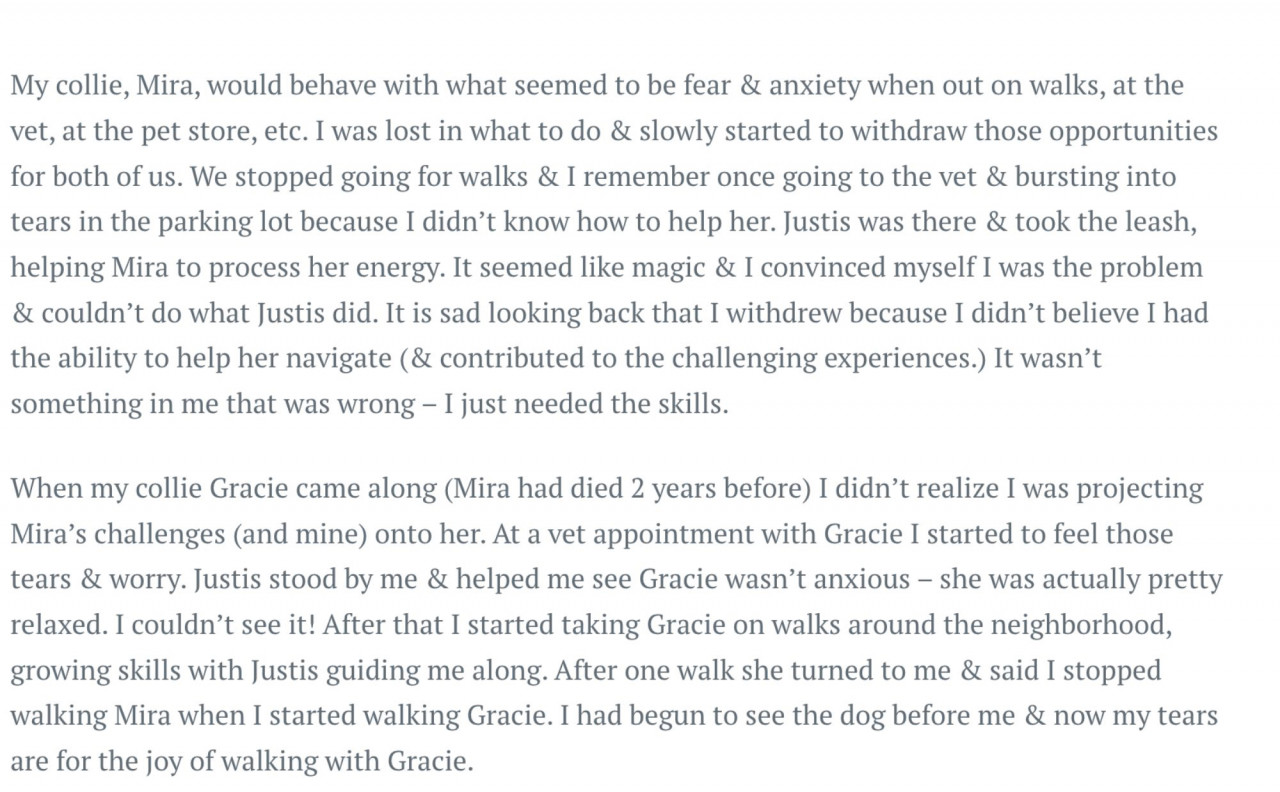For all the dogs who've touched our hearts
Know what’s normal – for your dog

Knowing what’s normal for your dog, Is a key to their health and happiness, when things change you can respond quickly & maybe save their life!

A key to health & happiness
What’s normal for a puppy is biting, playing and making noise. A quiet puppy means trouble!
As dogs grow older they become calmer (and usually quieter!) but knowing what’s normal is equally important for adult dogs, in fact it’s a key to their health and happiness!


Scallywag and the stick
(Never throw a stick for your dog!)
Our three dogs ran ahead eagerly, barking and panting as they vied for position. I held up the stick and threw it, still chatting to my friend. The dogs raced away in hot pursuit. Suddenly, Scallywag screamed. I ran to see what was wrong. She stood quietly while I felt her all over, but there was not a lump, cut or tear anywhere.
Later, I was relaxing with Scally curled up beside me. I’d checked her again when we got home and had not found anything, but she was quiet, not her usual bubbly self at all. An uncomfortable feeling stole over me. Something was not right, so I gently scooped her up and drove to the vet.
Dr. Josh was thorough. He examined her all over, carefully inspecting inside her throat, but he also couldn’t find anything wrong. We watched Scally standing on the table. She was so subdued. “Let’s put her under,” Josh said, “just in case.”
A few hours later I got a call. The stick had plunged deep into Scally’s throat, stabbing out a great wound. It was bleeding into her stomach. If I hadn’t responded to my nagging feeling, she could have died.
I’m so glad I knew what was normal for my terrific little terrier. She lived to be 16 and was always brimming with life. Our dogs don’t speak human, but they do say “I’m feeling sick” or “I hurt myself” in their own completely doggy ways – we just have to know them well enough to see when something isn’t right.
It’s not always easy. We lead busy lives and even with the best of intentions we miss signs. In this blog I’ll show you some of the most important ways our dogs say “All is not well.”
They may just save their life.

Scallywag enjoying time with my son Lachlan, many years ago
Changes in energy
Some dogs are Energizer Bunnies, some are couch potatoes and some are in-between. If your dog’s energy level changes, especially suddenly, pay attention.
Notice things like:
- Are they as keen for their walk?
- Are they as playful as usual?
- Are they wanting their normal cuddles?
- Are they sleeping for an unusually long time?
- Are they hard to wake up?
- Or are they more active than normal – fidgeting, wiggling, sniffing, scratching, nibbling more than usual?
Changes in Alertness
I can walk out of rooms, get up off the sofa and leave the house without Merlin paying too much attention. Bonnie, however, is a different story; she’s highly alert and always on my heels. *Normal* is different for each of them.
Notice things like:
- Are they as aware of and responding to neighbourhood sounds?
- Are they following you around in the usual way?
- Do they raise their head, prick their ears, shift their weight in response to the usual things?
- Do they seem unusually sleepy and unresponsive?
- Do they seem unusually vigilant and reactive?
Abnormal fear
Merlin and the scary lawn mower
Merlin stood in the middle of the path, his mouth hanging open, his ears lowered, his head swivelling from side to side. He was in a panic and I was puzzled. It was a clear, calm day, the only change in the environment was that our neighbour had started his lawn mower. Merlin was now 2 years old and had been hearing this sound his entire life. Why suddenly did it scare him?
Merlin’s fear of common sounds rapidly worsened, soon the air-conditioner, doors creaking, the wind, blinds being pulled up and down, the tv and coffee maker all began to worry him. We walked on egg shells, afraid that any sudden noise could cause him to panic.
Merlin was later diagnosed with Spondylosis of the spine and arthritis; although I didn’t know it at the time, it’s likely that tensing or startling at sounds caused pain which quickly generalised to everyday noises. Recent studies have suggested this link may be a common cause of the onset of fear in adult dogs.
Never underestimate the impact pain has on a dog’s behaviour.
Merlin showing fear behaviours because it started to rain
I took this video to document the way Merlin was responding to common sounds. It makes me sad to watch, but it does show fear behaviours clearly. Happily, Merlin is now fine with noises – except for rain.
Look for:
- Unusual reactiveness – (startling, barking, avoidance) to things that previously didn’t worry them.
- Fear responses such as shivering, shaking, running away or standing frozen to the spot.
- Avoidance behaviours such as moving away, lying down, rolling over – especially when asked to do things they previously enjoyed.
- Refusal to get in the car, jump on the bed or couch or not wanting to go for a walk.
- Abnormal grumpiness with other dogs or people.
- Extra clinginess, panting and pawing at you.
Changes in behaviour
Rocky and Sandy's story
Recently I noticed that Rocky’s habit of licking himself had escalated to where he seemed to be doing it all the time. He tends to be a nervous dog and gives me a hard time about brushing, so I don’t push it to happen often. Because of this I didn’t notice that his excessive licking had started to make the insides of his legs and belly bleed. Once I did notice, I immediately went to the veterinarian’s office for a check up.
The doctor told me he was seeing an increase in dogs with allergies this year. He said they would try some skin scrapings to see if they could find anything. I advised that I had had Rocky for a number of years and this had never happened before. He explained that similar to people, allergies develop at any time.
We were prescribed a medication and he was given a steroid shot to ease some of the irritation. We also used a medicated shampoo daily for thirty days. Fortunately they all seemed to do the trick, as Rocky slowed his licking within a few days, and rather quickly his skin appeared less pink and irritated.
I felt so bad that I didn’t notice his skin was causing him such distress! As a long time dog owner I have never experienced having a dog with allergies and I didn’t know it was becoming an issue.
Rocky gives our family so much love every day, I’m relieved this was able to be managed quickly!
– Sandy Barrett
Sandy, a caring, attentive dog owner, missed the early signs of Rocky’s problem because for him some licking is normal. Behaviour change is a key indicator of our dogs’ health and can happen suddenly, or slowly and subtly as it did with Rocky.

Rocky, relaxing happily on the deck - (photo by Sandy)
Look for:
- Any sudden change in behaviour such as a refusal to jump in the car or on the bed, saying “no” to well known cues like “sit” or unusual growling and grouchy behaviour.
- Any behaviours that have increased or decreased in frequency: barking, scratching, licking, jumping, circling, chewing and so on.
- Refusal to do things they normally love.
- Looking sad and droopy – ears down, lowered body posture, tail held unusually low, big sad eyes and a wrinkled brow.
- Extra clinginess – not wanting to leave your side or be separated from you.
- Extra aloofness – avoiding you, not wanting to be touched, choosing to sleep somewhere else.
Changes in posture and movement
Bella needs the physio
Bella the Border Collie leads a very active life: running, jumping, playing – she’s rarely still, but recently Sue and Jan noticed she wasn’t moving with her usual grace. Several examinations and an Xray later, Bella has been diagnosed with a minor back problem. Bella is only 3 years old and her youthful enthusiasm could easily disguise her injury, but thanks to Sue and Jan’s vigilance and knowledge of what’s normal for her, she will soon be free to enjoy lots more pain free running.
Knowing what posture and movement is normal and healthy for your dog is very important. Pay close attention to the way your dog stands and moves when they are young and well. It can also be a good idea to study pictures and videos of good dog structure and movement in case there’s an underlying issue that hasn’t been identified (as with Merlin). If you have a specific breed of dog, look at pictures and videos of your breed; if you have a mixed breed knowing what comprises good movement and structure generally will help you learn about your dog. I’ve included links in the reference section below.

Bella enjoying her good health - (photo by Sue)
Look for:
- Unusual stiffness, especially when getting up after resting
- Changes in the way they stand – are they favouring a leg/paw? Is their back a bit arched? Is their tail tucked?
- Changes to the fluidity of movement when walking, trotting and running – does it look easy, comfortable or is it laboured and uneven. Has it changed in any way?
- Are they pacing, especially when off lead?
- Can they move easily into different positions such as sit, down and stand or do they shuffle, groan, adjust position or hit the floor with a thud.
- As previously mentioned pay attention to refusal or reluctance to walk, play, jump or engage in other previously enjoyed activities.
Other important signs
The list below provides key indicators to our dogs’ health and happiness – whether from age, allergy or illness. Paying attention to deviations from normal could save or prolong their lives.
- Changes in appetite – more or less than normal.
- Changes in weight – particularly if out of proportion to appetite.
- Changes in thirst – is the water bowl being emptied more quickly?
- Changes in coat – appearance, smell and feel.
- Changes to the eyes – discharge, swelling, colour, clearness and brightness.
- Changes to the ears – rubbing, scratching, unusual smell or discharge.
- Changes to the skin – abnormal lumps particularly ones that grow rapidly. Changes to colour, feel and smell.
- Persistent changes in stools – shape, consistency, size, colour and smell (yes smell!) Amount of time needed to eliminate (straining) and frequency.
- Changes in urination – odour, colour and frequency as well as discomfort or reluctance to go, or sudden peeing inside the house.
- Changes in sleeping patterns.
- Vomiting
Do your best
One thing I’ve learned over the years is that we don’t always get it right, it takes time and knowledge to know what’s normal. I hope this blog gives you a place to start, but my best advice is to spend time watching, learning and loving what’s normal for your special pal.
Your tips?
I’ve done my best to be thorough without writing a book, but there’s always something else to know. If you have any tips or stories I’d love to hear them in the comments below.
And if you enjoyed this blog, please scroll down and subscribe!

Big thanks to Sandy Barrett and her lovely boy Rocky for the inspiration for this article. Sandy writes an excellent blog called Make A Change Project filled with practical and topical advice on what we can do to make the world a better place. Head on over and have a look!

References and resources
Noise Sensitivities in Dogs: An Exploration of Signs in Dogs with and without Musculoskeletal Pain Using Qualitative Content Analysis, Frontiers in Veterinary Science, Animal Behaviour and Welfare
Dogs with noise sensitivity should routinely be assessed by vets for pain, Phys org
New Study Shows Importance of Understanding Dog Behaviour: A study of pain shows why one should become “fluent” in dog, Marc Beckoff PhD
Built to Last: The Basics of Canine Conformation and Anatomy, American Kennel Club
Structure and Movement Part 1, Breeding Better Dogs
Structure and Movement Pt 1, McCleary Animal Hospital
Course on Structure and Movement, Sue Ailsby – Fenzy Academy
Dogs in Motion: Prof. Dr. Martin S. Fischer (40 min video presentation)
Coat and Appearance in the Healthy Dog, VCA
Should I Worry About My Dog’s Lump? Leesville Animal Hospital
What to Do When Your Dog’s Appetite Suddenly Changes? Dr.Karen Becker

You might also like



Comments








Comments
Never miss a thing!

 Julie van Schie
Julie van Schie 



